This article includes a list of general references, but it lacks sufficient corresponding inline citations .(December 2015) |
This is a list of notable or recurring items from the BBC television series Doctor Who .
This article includes a list of general references, but it lacks sufficient corresponding inline citations .(December 2015) |
This is a list of notable or recurring items from the BBC television series Doctor Who .
The Fifth Doctor wears a sprig of celery in his lapel. He claims that he is allergic to certain gases in the praxis range; if those gases were present, the sprig would turn purple, at which point he would eat it. Peter Davison asked for this explanation to be included in The Caves of Androzani , as it was his final story. It is referred to later in the same story by the Doctor as "a powerful restorative where I come from..." The Doctor acquires the celery in Castrovalva and replaces it in Enlightenment .
A piece of plastic celery from the series fetched £5,500 (equivalent to £9,638in 2023) for charity when sold at an auction in November 2007. [1]
The Chameleon Circuit is a component of the TARDIS that allows it to change shape to match its surroundings and remain inconspicuous. The circuit has malfunctioned, leaving it stuck in the shape of a 1960s style British police box. Attempts to repair the circuit have led to unpredictable results, including the TARDIS taking on the form of a pipe-organ. Since then, the Doctor has said that he has become fond of the police box form and has stopped trying to repair it. The TARDISes owned by the Master, the Rani, and the Monk have fully functioning chameleon circuits. In series one episode "Boom Town", the Ninth Doctor explains to Captain Jack Harkness and Mickey Smith about the chameleon circuit and why the TARDIS has been "permanently" imaged as a police box. In the episode "Journey's End", when Donna Noble has the Doctor's knowledge in her head due to an instantaneous biological meta crisis, she starts to tell the Tenth Doctor how he can fix the chameleon circuit before the knowledge in her head overwhelms her. The Eleventh Doctor explains to Amy Pond (set between "The Eleventh Hour" and "The Beast Below" in a deleted scene featured on the Series 5 boxset special Meanwhile in the TARDIS) that the TARDIS takes a 12-dimensional scan of the surrounding area and determines what the best thing to turn itself into is. Even though the circuit is broken, the TARDIS can still turn invisible, as shown in The Invasion and "The Impossible Astronaut", the former due to a Cyberman attack that causes the visual stabilizer to malfunction. In the comic, "Hunters of the Burning Stone", it is revealed the circuit is intentionally broken in the First Doctor's TARDIS by the Eleventh as part of a plan to stop the Tribe of Gum.
The Eye of Harmony is an artificially created black hole made by Omega, used by the Time Lords as a power source for time travel. The 1996 film Doctor Who , and the episode "Journey to the Centre of the TARDIS", suggests that there is more than one Eye of Harmony, or that the Doctor needs to get one of his own after the Cardiff Rift sealed itself and no more energy could be siphoned off of its scar.
The Hand of Omega is a device that can collapse a star into a black hole. Omega supposedly used this device to harness the energy and negative continuum inside it to enable time travel. It can also be used to destroy entire star systems by taking out the magnetic fields surrounding atoms. The counteraction of this device occurs in the seventh doctors' story, Remembrance of the Daleks .
A dream diary, containing notes and sketches by the Tenth Doctor's human persona, John Smith, in "Human Nature" and "The Family of Blood". The title is handwritten on the journal's first page. Referred to by Smith as "stories", it is shown on screen as scribbled words and what appear to be ink sketches, recording what Smith remembers from dreams about his adventures as the Doctor. Joan Redfern retains the Journal at the end of "The Family of Blood", and it is eventually published in 2009 by her granddaughter in "The End of Time".
One two-page spread contains illustrations of all ten Doctors to date, as seen on a flash animation on the BBC web site at the time of "The Family of Blood" air date. The drawings seen on screen in "Human Nature" are of the First, Fifth, Sixth, Seventh, and Eighth Doctors, the first time each has been depicted in the revived series. [2] The journal also features sketches of the TARDIS interior and exterior, a sonic screwdriver, the Torchwood Institute logo, K-9, Rose Tyler, Autons, clockwork androids, Cybermen, Daleks, the Moxx of Balhoon, gas-masked people from "The Empty Child"/"The Doctor Dances", and the Slitheen.
The text includes repeated phrases describing key concepts (such as "magic box", referring to the TARDIS), along with many misspellings. One repeated phrase, "bigger inside than outside", also appears in Latin as: Maius Intra Qua Extra. The Journal prop was created by artist Kellyanne Walker and incorporates text provided by writer Paul Cornell. [3]
The most powerful artifact in the universe that is capable of anything the user can imagine. It can restore balance to the universe, or cause utter chaos. Both the Black and White Guardians seek it, but the Doctor prevents the former from gaining control of it by scattering it across time and space.
The Matrix is a computer system that contains the collective of all Time Lord knowledge. It first appeared in the 1976 serial The Deadly Assassin . The Matrix can only be accessed by the President of the High Council of Time Lords through an item known as the Crown of Rassilon, though a person assuming the role known as the Keeper of the Matrix also holds a key to access it. Access to the Matrix is restricted to most Time Lords.
The Matrix contains biological imprints of all Time Lords and memories of deceased Time Lords. It also receives input from TARDIS time machines piloted by Time Lords, allowing the Matrix to make predictions of the future. In The Trial of a Time Lord, the Matrix is shown to be capable of creating virtual reality worlds within itself. The Matrix is also shown to use Cloister Wraiths and captured alien invaders to defend itself following the Time War, as seen in "Hell Bent". The Matrix has appeared in a variety of other Doctor Who spin-off media.
Psychic paper is a blank, white visitor's card that has special properties. When shown to a person, it can usually induce them to see whatever the user expects, wishes, or needs them to see printed on it. In "Revolution of the Daleks," the Thirteenth Doctor gifts two pieces of psychic paper to companions Ryan Sinclair and Graham O'Brien upon their departure from the TARDIS.
The Tenth Doctor's severed right hand is kept in a transparent case filled with a preservative liquid. It is severed by a Sycorax sword during their invasion of Earth ("The Christmas Invasion"). The Doctor regrew the hand due to the healing after-effects of his recent regeneration. Captain Jack Harkness retrieved the hand and stored it at the Torchwood Hub. [4]
In the Torchwood episode "End of Days", the hand glows when the TARDIS is heard materialising in Cardiff. Alerted by the hand, Jack finds the Doctor in "Utopia", and he describes the hand as a "Doctor detector"; at the end of the episode, the hand is stolen by the Master along with the Doctor's TARDIS. In "The Sound of Drums", the Master reveals he has used the hand to derive the Doctor's biological code, with which he accelerates the Doctor's ageing by one hundred years using his laser screwdriver. After the events of "Last of the Time Lords", the Doctor recovers the hand.
It is later seen at the end of the episode, "The Poison Sky", where it glows as it did in "End of Days". In "The Doctor's Daughter", this instance of glowing is explained as sensing the appearance of the Doctor's genetic material, in the form of Jenny, in another time period.
At the end of the episode "The Stolen Earth", the Doctor is shot by a Dalek and is forced to regenerate, but in the following episode, "Journey's End", the Doctor transfers the regeneration energy into the hand, allowing him to heal his wounds but still keep the same form. Donna later touches the hand while it is still infused with regeneration energy, causing the hand to regenerate into a half-human, half-Time Lord copy of the Doctor, with the side effect of giving Donna the knowledge of a Time Lord.
Featured in "The Doctor Dances", the sonic blaster, also known as a "squareness gun", is a handheld weapon from the 51st century. The one featured is owned by Captain Jack Harkness. It fires in a peculiar square shape rather than the more traditional round pattern of most science fiction weapons. In "Silence in the Library", set in the 51st century, Professor River Song possesses a weapon which acts in exactly the same manner, and Steven Moffat, author of both stories, says it is the same item, left in the TARDIS by Jack and taken by River during her time with the Doctor, a time which is actually in the future of the Doctor's personal timeline. [5]
In "Revolution of the Daleks," Jack is armed with a sonic blaster while helping the Thirteenth Doctor and her companions investigate a Dalek threat on Earth. Yasmin Khan is unimpressed with his use of it to open a hole in a door, but Jack is later able to kill two attacking Dalek mutants with the gun.
The "superphone" is an upgraded mobile phone that can make calls across time and space. It even calibrates to the user's home time period, as shown by Adam Mitchell's ability to call his home time on Rose Tyler's phone ("The Long Game"), despite their native time periods being about six years apart. In addition, it can send signals in places ordinary phones cannot, such as the sealed Cabinet Rooms at 10 Downing Street ("World War Three"). However, its range is not infinite ("The Impossible Planet"). The Doctor describes the superphone as being able to "call anyone, in any time, so long as you know the area code".
The superphone first appears in "The End of the World", where the Ninth Doctor modifies Rose's Nokia 3200 mobile phone with a special device that goes in place of the battery. In "Rise of the Cybermen", the Nokia 3200 is replaced by a Samsung D500, but otherwise seems to function the same. A Samsung D500 is also seen used by Tish Jones in "The Sound of Drums". It is also able to link with the Cybus Industries Ear-Pod network. Rose gives the phone to Mickey Smith at the end of "The Age of Steel", but replaces it soon after.
When Martha Jones becomes an ongoing companion to the Tenth Doctor in "42", he gives her phone, the BenQ-Siemens EF81, a similar upgrade. This phone, however, is upgraded by the Doctor's sonic screwdriver, and the feature itself is referred to as "Universal Roaming". Martha's phone has the Archangel network logo on its display, the significance of which is revealed in "The Sound of Drums". At the end of the episode "Last of the Time Lords", Martha gives her phone to the Doctor, so she can contact him if trouble occurs.
The Doctor uses the same process to upgrade Donna Noble's phone in "The Doctor's Daughter", but it is only used once onscreen to contact Martha's similarly upgraded phone. When his allies try contact the Doctor in "The Stolen Earth" by means of Martha's superphone now in his possession, the number displayed onscreen is 07700 900461. After the airing of this episode, 2,500 fans tried to dial the number. [6] In "Journey's End", Wilfred mentions that he has received a phone call from Donna, presumably by means of her superphone.
There are at least two superphones available for use in the Eleventh Doctor's TARDIS; Amy Pond's phone and a flip phone sometimes used by the Doctor. Special Agent Delaware used Amy Pond's cell phone to receive a call from the Doctor's flip phone in 1969, before cell networks existed, indicating that both phones must have been upgraded by the Doctor at some point ("Day of the Moon"). In "The Doctor's Wife", the Doctor uses Amy's phone to keep in touch with Amy and Rory, who are trapped inside the TARDIS. Rory is shown to have one in "Dinosaurs on a Spaceship", with his father questioning the oddity of it; Rory commented, "You get used to it."
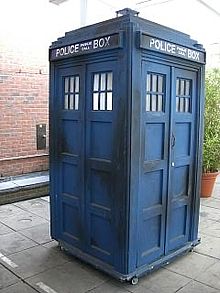
A TARDIS (Time And Relative Dimension In Space) is a spaceship invented by the Time Lords that can travel through space and time. The Doctor travels in a Type 40 TARDIS. A TARDIS can travel to any time and place in the universe, except to events that are Time-Locked, such as the Time War. The TARDIS is bigger on the inside than the outside, and its main fuel is Artron energy, a positive time synergy that can almost penetrate time gates.[ clarification needed ] In "The Impossible Planet" it is stated that TARDISes are grown, rather than built, and that no other TARDIS could be created, as the last seeds for them were destroyed in the Time War.
The Time Scoop was a primitive 'Time Corridor' technology created on Gallifrey during the Dark Time, similar in sophistication to Dalek time-travel technology. Its purpose was to remotely 'scoop' individuals from their own time period and deposited them within the Death Zone, a securely controlled environment on Gallifrey. Those kidnapped were then expected to compete in gladiatorial games. In "The Five Doctors", the Scoop was used to fetch various incarnations of the Doctor and his companions to the Death Zone, along with various foes such as the Daleks, Cybermen, and Yeti. The Time Scoop plays a minor role in the Eighth Doctor Adventures novel The Eight Doctors , and a major role in the final chapter of the Gallifrey audio series.
A vortex manipulator is a simple form of time travel used by Time Agents in the future. It is a small device mounted in a leather wrist strap that allows the user to travel through time and space. It is stated to be a much more primitive form of time travel than a TARDIS, and has been said to be unpleasant to use. It is also capable of teleporting the user without travelling through time. The most notable user of a vortex manipulator is Captain Jack Harkness, who possessed one from his time as a Time Agent. After being abandoned in the year 200,100 by the Doctor, he attempted to use his manipulator to travel to 21st century Earth to find him, but the device malfunctioned and took him to the 19th century, where it subsequently burnt out and was rendered non-functional (at least the time travel and teleport function, other functions were shown to be working). After the Master stole the Doctor's TARDIS, the Doctor repaired Jack's manipulator and used it to transport him, Jack, and Martha Jones from the end of the universe to 21st century Earth, although he subsequently deactivated the device to prevent Jack from misusing it. Jack later managed to reactivate it again to meet up with the Doctor, but once again it was later deactivated.
Other notable users of vortex manipulators include River Song, Clara Oswald (who used Jack's manipulator), Missy, and the Doctor.

The sonic screwdriver is a fictional multifunctional tool in the British science fiction television programme Doctor Who and its spin-offs, used by the Doctor. Like the TARDIS, it has become one of the icons of the programme, and spin-off media such as The Sarah Jane Adventures and Torchwood have replicated its functions in devices such as the sonic lipstick, sonic blaster, sonic probe, sonic modulator and sonic cane.

The TARDIS is a fictional hybrid of a time machine and spacecraft that appears in the British science fiction television series Doctor Who and its various spin-offs. While a TARDIS is capable of disguising itself, the exterior appearance of the Doctor's TARDIS typically mimics a police box, an obsolete type of telephone kiosk that was once commonly seen on streets in Britain in the 1950s. Paradoxically, its interior is shown as being much larger than its exterior, commonly described as being "bigger on the inside".

The Time Lords are a fictional ancient race of extraterrestrial people in the British science fiction television series Doctor Who, of which the series' main protagonist, the Doctor, is a member. Time Lords are so named for their command of time travel technology and their non-linear perception of time. Originally, they were described as a powerful and wise race from the planet Gallifrey, from which the Doctor was a renegade; details beyond this were very limited for the first decade of the series. They later became integral to many episodes and stories as their role in the universe developed. For the first eight years after the series resumed in 2005, the Time Lords were said to have been destroyed during the Last Great Time War at some point in the show's continuity between the television movie in 1996 and the show's revival. In 2013, the 50th anniversary special "The Day of the Doctor" concerned this supposed destruction and their eventual survival.

The Master, or "Missy " in their female incarnation, is a recurring character in the British science fiction television series Doctor Who and its associated spin-off works. They are a renegade alien Time Lord and the childhood friend and later enemy of the title character, the Doctor. They were most recently portrayed by Sacha Dhawan.
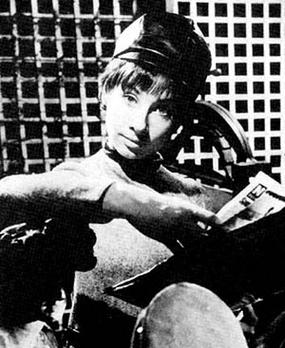
Susan Foreman is a fictional character in the British science fiction television series Doctor Who. The granddaughter of the Doctor and original companion of their first incarnation, she was played by actress Carole Ann Ford from 1963 to 1964, in the show's first season and the first two stories of the second season. Ford reprised the role for the feature-length 20th anniversary episode The Five Doctors (1983) and the 30th anniversary charity special Dimensions in Time (1993).

Rassilon is a fictional character in the British science fiction television series Doctor Who. In the backstory of the programme, he was the founder of Time Lord society on the planet Gallifrey and its first leader, as Lord High President. After the original television series ended in 1989, Rassilon's character and history were developed in books and other media.

The Doctor is the protagonist of the long-running BBC science fiction television series Doctor Who. An extraterrestrial Time Lord, the Doctor travels the universe in a time travelling spaceship called the TARDIS, often with companions. Since the show's inception in 1963, the character has been portrayed by fourteen lead actors. The transition to each succeeding actor is explained within the show's narrative through the plot device of regeneration, a biological function of Time Lords that allows a change of cellular structure and appearance with recovery following a mortal injury.
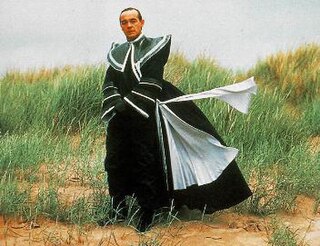
The Valeyard is a fictional character from the long-running British science fiction television series Doctor Who. He is described by the Master as an amalgamation of the Doctor's darker sides from between his twelfth and final incarnations. In the story The Trial of a Time Lord, comprising the whole of Season 23, the High Council of the Time Lords appoint the Valeyard as prosecutor at the Sixth Doctor's trial, hoping to have him executed and thereby removing the sole witness to their near destruction of life on Earth.

Mickey Smith is a fictional character in the BBC One science fiction television series Doctor Who. He is portrayed by British actor Noel Clarke and was the show's first televised black companion. The character is introduced as the ordinary, working class boyfriend of Rose Tyler, a London shopgirl who becomes a travelling companion to the Ninth and Tenth incarnations of an alien Time Lord known as the Doctor. Mickey first appears in the first episode of the 2005 revival, "Rose". Initially someone who struggles in the face of danger, Mickey nevertheless acts as an Earth-based ally to the Doctor and Rose. In the second series he joins the pair as a second companion of the Doctor's, though he leaves during the 2006 series to pursue his own adventures. He returns to aid the Doctor and Rose in the series finale later that year, and then again for the 2008 finale "Journey's End," as well as fleetingly in 2010 in the Tenth Doctor send-off "The End of Time".
"The Parting of the Ways" is the thirteenth episode and the season finale of the revived first series of the British science fiction television programme Doctor Who. The episode was first broadcast on BBC One on 18 June 2005. It was the second episode of the two-part story. The first part, "Bad Wolf", was broadcast on 11 June.

The Second Doctor is an incarnation of the Doctor, the protagonist of the British science fiction television series Doctor Who. He was portrayed by actor Patrick Troughton. 53 of his 119 episodes are missing.
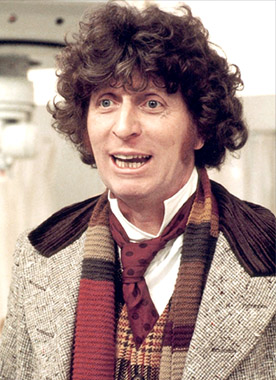
The Fourth Doctor is an incarnation of the Doctor, the protagonist of the British science fiction television series Doctor Who. He is portrayed by Tom Baker.
The Time War, also called the Last Great Time War, is a conflict within the fictional universe of the British science fiction television series Doctor Who. The war occurs between the events of the 1996 film and the 2005 revived series, with the Time Lords fighting the Daleks until the apparent mutual destruction of both races. The war was frequently mentioned when the show returned, but was not directly seen until the show's 50th anniversary special.
The Time Lords are a fictional humanoid species originating on the planet Gallifrey, seen in the British science fiction television series Doctor Who. They are called "Time Lords" because of their ability to travel in and manipulate time through prolonged exposure to the time vortex.

In the long-running British science fiction television series Doctor Who, regeneration is a biological ability exhibited by the Time Lords, a race of fictional humanoids originating on the planet Gallifrey. This process allows a Time Lord to undergo a transformation into a new physical form and a somewhat different personality after instances which would normally result in death. Regeneration has been used multiple times throughout the history of the show as a device for introducing a new actor for the lead role of its main character, the Doctor. Other Time Lords and similar characters have also regenerated, usually for narrative reasons, rather than casting.
"The Sound of Drums" is the twelfth episode of the third series of the revived British science fiction television series Doctor Who. It was broadcast on BBC One on 23 June 2007. It is the second of three episodes that form a linked narrative, following "Utopia" and followed by "Last of the Time Lords".
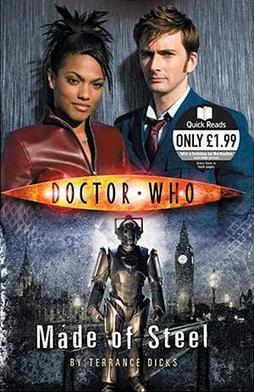
Made of Steel is a BBC Books original novella written by Terrance Dicks and based on the long-running British science fiction television series Doctor Who. It features the Tenth Doctor and Martha. This paperback is part of the Quick Reads Initiative sponsored by the UK government, to encourage literacy. It has a similar look to BBC Books' other new series adventures, except for its much shorter word count, being a paperback and not being numbered as part of the same series. To date it is the one of only five novels based upon the revived series that have not been published in hardcover: the first, I am a Dalek, was published in May 2006; the third, Revenge of the Judoon, was published in March 2008; the fourth, The Sontaran Games, was published in February 2009; and the fifth, Code of the Krillitanes, was published in March 2010. These four books are also part of the Quick Reads Initiative.
"Last of the Time Lords" is the thirteenth and final episode of the third series of the revived British science fiction television series Doctor Who. It was broadcast on BBC One on 30 June 2007. It is the last of three episodes that form a linked narrative, following "Utopia" and "The Sound of Drums".

"Journey's End" is the thirteenth and final episode of the fourth series of the British science fiction television series Doctor Who, which was first broadcast on BBC One on 5 July 2008. It is the second episode of a two-part crossover story featuring the characters of spin-off shows Torchwood and The Sarah Jane Adventures, preceded by "The Stolen Earth", which aired on 28 June. At 65 minutes in length, it was approximately 20 minutes longer than a standard fourth-series episode. It marked the final regular appearances of every companion introduced in the Russell T Davies era, including Catherine Tate as Donna Noble.

The Eighth Doctor is an incarnation of the Doctor, the protagonist of the British science fiction television series Doctor Who. He is portrayed by Paul McGann.